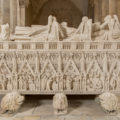
Le 5 mai dernier, André Matthys est décédé à l’âge de 75 ans. Les Amis de l’Abbaye Noble de Clairefontaine (Amanoclair) pleurent ainsi le décès d’un de leurs membres. Diplômé en histoire et en archéologie, il fut l’élève de Joseph Mertens à l’Université catholique de Louvain. De 1991 à 2007, André Matthys fut le premier Inspecteur général du Patrimoine de la Région wallonne. Il parvint à faire du Patrimoine un moteur important de la Wallonie. Grâce à lui, un chantier de fouilles archéologiques de plusieurs années a été rendu possible à Clairefontaine, sous la direction de son ami, l’archéologue Johnny De Meulemeester. En l’an 2000, à l’occasion de l’inauguration de la chapelle Notre-Dame du Bel-Amour restaurée, André Matthys représentait à Clairefontaine le ministre du patrimoine, au nom duquel il prononça un discours. Suite à ces différents chantiers, André Matthys était devenu un membre incontournable d’Amanoclair, qui ne manquait pas de prodiguer ses précieux conseils dans l’intérêt de l’association. André Matthys était également un homme jovial et empathique, grand amateur de bonne chair. Il saluait indifféremment l’ouvrier et le directeur, faisant preuve d’une égale sympathie à leur endroit. Il était animé d’un véritable esprit humaniste.



